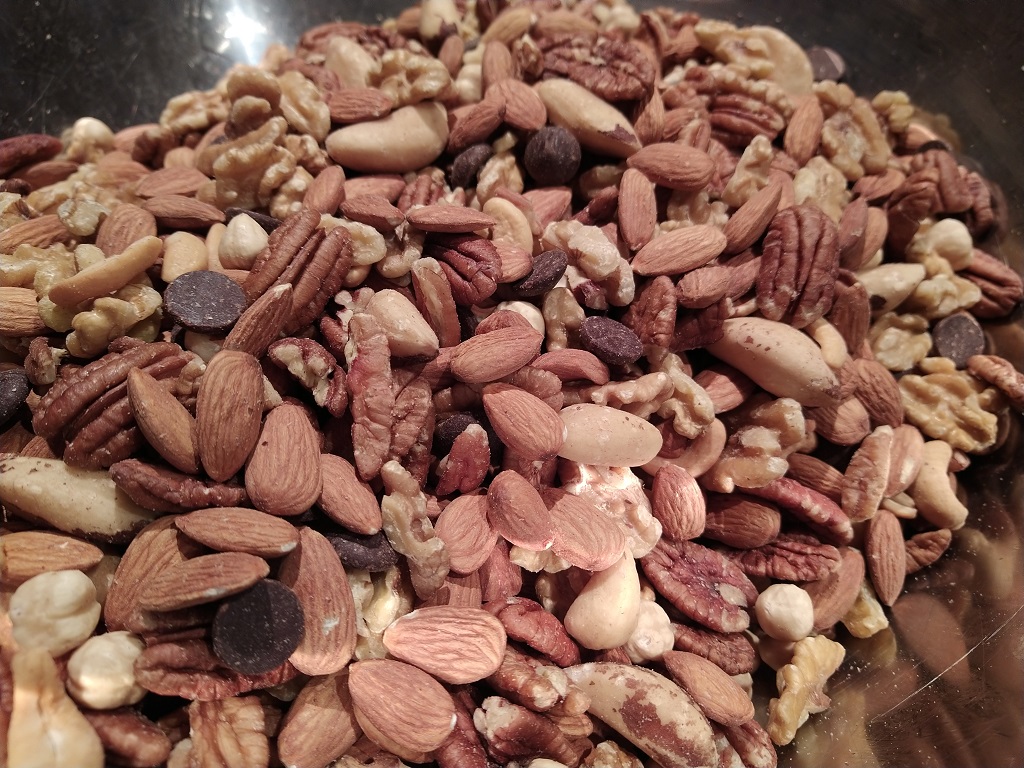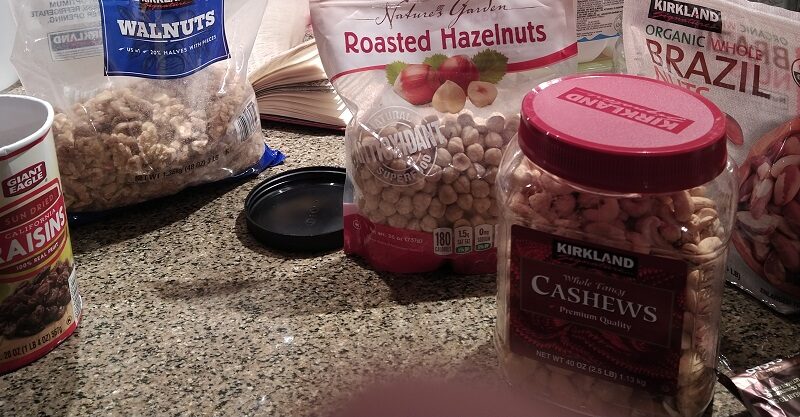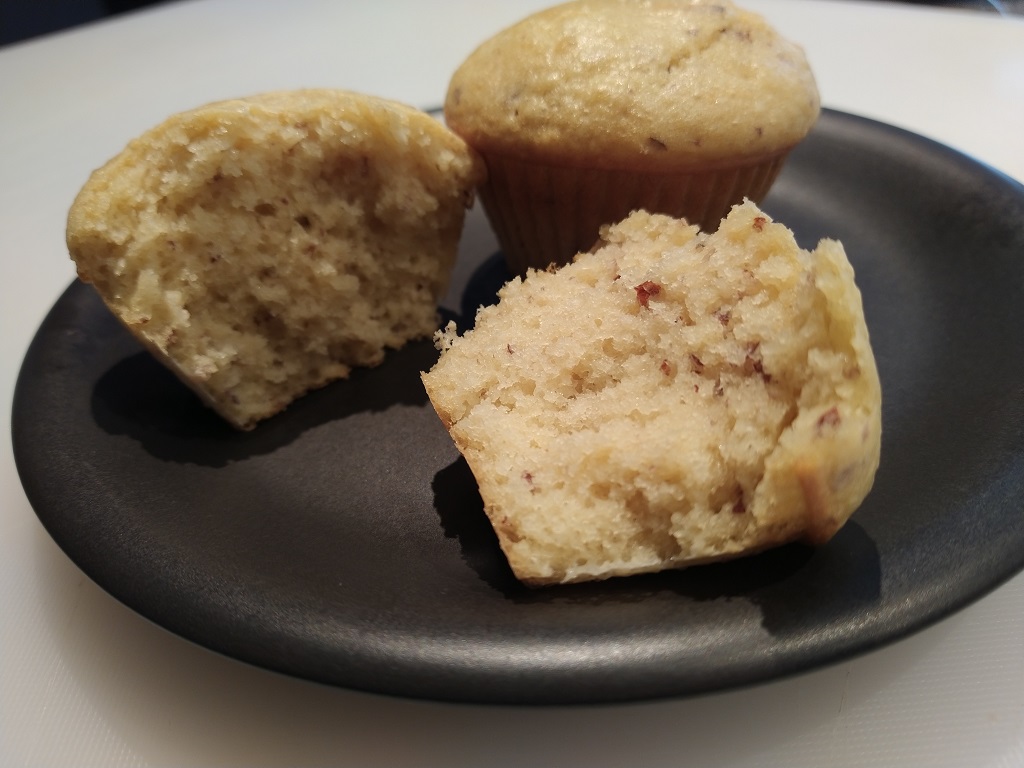OK, now we’re ready for winter 🙂
Author: Lisa
Trail Mix
Trail Mix
Course: SnacksDifficulty: EasyIngredients
3 lbs whole almonds
27 oz walnuts halves and pieces
13 oz cashews
8 oz hazelnuts
8 oz Brazil nuts
2 lbs pecans – halves and pieces
10 oz bittersweet chocolate chips
12 oz raisins
Method
- Mix all of the nuts together in a large bowl
- Take half of the nut mixture and put aside for later. Combine raisins with remaining nuts.
We found a ton of different nuts at Costco — almonds for $3.33 a pound, pecans and walnuts for about the same price. The best price I’d found for almonds was about $5 a pound, and that was at a bulk wholesale place where you had to buy something like fifteen pounds. This is a three pound bag, and the price includes shipping. Cashews, hazelnuts, and Brazil nuts were all a little more expensive, but still significantly less than what I buy them for at a bulk / wholesale place. So we made trail mix (and have plenty of nuts left over to make more trail mix throughout the year). I need to make some dehydrated bananas, apples, and cranberries to add in … but it’s tasty already!

Apache HTTPD and DER Encoded Certificate
We are in the process of updating one of the web servers at work to a newer OS – along with a newer Apache HTTPD and PHP iteration. Ran into a snag just setting up the SSL web site – we couldn’t get HTTPD started with our Venafi certificate.
[Fri Jan 28 14:35:05.092086 2022] [ssl:emerg] [pid 57739:tid 139948816931136] AH02561: Failed to configure certificate hostname.example.com:443:0, check /path/to/certs/production/server.crt
[Fri Jan 28 14:35:05.092103 2022] [ssl:emerg] [pid 57739:tid 139948816931136] SSL Library Error: error:0909006C:PEM routines:get_name:no start line (Expecting: CERTIFICATE) — Bad file contents or format – or even just a forgotten SSLCertificateKeyFile?
[Fri Jan 28 14:35:05.092115 2022] [ssl:emerg] [pid 57739:tid 139948816931136] SSL Library Error: error:140AD009:SSL routines:SSL_CTX_use_certificate_file:PEM lib
The certificate was DER encoded – that’s not what I use, but it was working on the old server.

I think there might be something between httpd-2.4.6-97 and httpd-2.4.37-43 that stopped DER encoded certificates from working. Rather than figure out some way to coerce HTTPD to use this DER file that I don’t really care if I’ve got … I just used a quick command to export the B64 version of the certificate, copied the header/footer/stuff in between, and made a base-64 encoded certificate file.
openssl x509 -inform DER -in server.crt | openssl x509 -text
And, voila, we’ve got a web server.
First Robins of 2022
I saw the first robins today, but I was not able to get a picture 🙁 A whole flock were perched in the sumac tree along the ridgeline by our chicken coop — I presume pecking through the last seeds still sticking to the tree. They flew away seconds after I registered the colouring and thought “hey, robins!”.
First time cracking eggs successfully
Buttermilk Almond Muffins
Ingredients:
- 1 1/2 cups all-purpose flour
- 3/4 cup almond meal from making almond milk
- 1/3 cup maple syrup
- 1 tsp baking powder
- 1 tsp baking soda
- 1/2 tsp salt
- 2 eggs
- 5 Tbsp powdered buttermilk
- 1 1/4 cup water
- 4 Tbsp melted butter
Method:
- Preheat oven to 350 F — I lined the muffin tin with silicone cups. This made removing the muffins from the tin and clean up much easier.

- Stir almond meal into flour and break up any clumps of almond meal.
- Whisk in baking powder, baking soda, salt, and powdered buttermilk.
- In a separate bowl, slightly beat eggs then mix in maple syrup and water.
- Add wet ingredients to dry ingredients and stir gently to incorporate.

- Drizzle in melted butter and stir to incorporate.
- Divide batter into muffin pan.

- Bake 15-20 minutes until a toothpick inserted into the center comes out clean.

The leftover pulp from making fresh almond milk was always a problem — I know you can dry it out and make almond flour, but that’s a long process. I keep trying to find a tasty use for the pulp, and I think I’ve finally figured something out. These muffins were moist, buttery, had a bit of bite from the buttermilk … and a double batch would use all of the pulp from a batch of almond milk. Muffins freeze well, too — so we can have quick breakfast/snack food stashed in the freezer.
On Five Dollar Gas
This is the third or fourth time in the last decade that I’ve been seeing news reports about “5 dollar gas” or, more generally, astronomical rise in petroleum prices. How much it costs to fill a tank, how much a gallon costs, how this impacts family budgets.
Oddly, I’ve never seen any reporting discuss ways to minimize the impact that higher gasoline prices have. Any help at all, from the trivial (make sure your tires are well inflated, drive at less congested times to avoid idling in traffic, plan excursions so you’re not making a trip “into town” for different errands three days in a row) to the expensive (buy a more fuel efficient car). There’s nothing.
This is how the free market works — something becomes expensive, you need to consider other options. Buying an electric car isn’t cheap — expensive enough that it’s not an option for some people. But driving an electric car is a way to minimize the direct impact fuel prices have on you. At an enterprise level, electric trucks can reduce the indirect impact of fuel prices.
Turkey Meatballs
Turkey Meatballs
Course: FoodCuisine: American, ItalianDifficulty: Easy30
minutes30
minutesIngredients
2 pounds ground turkey
1 cup panko bread crumbs
1/3 cup Parmesan cheese
3 large cloves of garlic, finely chopped
1/2 cup minced onion
2 eggs
1/2 tsp black pepper
1 tsp salt
1/2 tsp basil
1/2 tsp oregano
Method
- Combine all ingredients in a bowl and mix until just combined.
- Either:
Fry in a pan to brown.
– or –
Place on a baking sheet lined with a silicone baking mat. Bake at 350F for about 25 minutes. - If using in a tomato sauce, slightly under-cook meatballs in step #2 , add to sauce, and simmer until fully cooked.
The HHGTTG Approach to Cloture
In 1975, the Senate adopted a rule change that makes me think of the beginning of Hitchhiker’s Guide to the Galaxy. A chap’s house is scheduled for demolition for “progress” — a new motorway. He lays down in front of the bulldozer to prevent his house from being smashed to bits, but his neighbor wants to hop over to the pub. So they explain to the crew manager that the chap could spend the day laying in front of the bulldozer; and, as such, it should be taken that he is laying in front of the thing even if he’s not. In the book, the answer is immaterial since the entire planet is slated for destruction so an interstellar motorway can be put in … and the discussion is meant to be fascicle regardless.
A filibuster isn’t really a legal construct — debate in the Senate could continue until everyone has had their say. That’s a process intentionally designed to slow legislation — to prevent knee-jerk responses to immediate situations. Using your ability to keep “debating” the bill to stall (or table) a bill is known as filibustering. Since 1917, Senate Rule 22 defines a “shut up and let’s vote” process (cloture) that closes debate on a bill and moves it to vote. It takes more people to invoke cloture than it does to pass a bill — 67 votes in 1917, 60 votes since 1975 — meaning the minority party potentially could stall legislation until the majority party gives up on it. Unfortunately, another change adopted in 1975 — the HHGTTG one — seems to operate on the idea that … just because you could continue debating a bill for a month means that you are doing it. And, as such, you don’t really need to stand and talk. With the rule change, the minority party could require a 3/5 majority to pass any legislation by requiring a cloture vote.
Prolonging debate on a bill requires a lot of dedication — and one dude isn’t going to be particularly effective in doing so. How long can one person actually speak from the floor? Strom Thurman holds the record at just over 24 hours with a soliloquy in opposition of the 1964 Civil Rights Act. But it wasn’t just Thurman — a whole group of Senators combined to prolong debate for sixty days. Eventually there were 67 votes to close debate (and the law passed).
Since 1975, the Senate’s approach to cloture (a.k.a. the filibuster) uses HHGTTG’s bulldozer reasoning — someone could stand on the Senate floor and talk for a long time. We should all assume they are talking on the Senate floor for an infinite period of time, thus a 3/5 majority is required to close debate and bring the bill to vote.
I think the Democrats today are making a massive tactical / branding mistake — instead of trying to “reform” or “eliminate” the filibuster, they should simply eliminate the HHGTTG component whilst pointing out how silly the idea is. If you want to marshal a group of Senators to keep talking for sixty days, have at it. But you’ve got to actually talk for sixty days. Sure, read every state’s voting laws. Read every state’s laws that might almost kinda be related to voting laws — ID is required, so lets read all about how to get a drivers or non-drivers ID in each state. Read research papers about voting rights. Read speculative information about how online voting could be implemented. Read the entirety of cases from states where courts have ruled on gerrymandered districts. But you cannot just say “I would prolong debate on this forever, so bring a cloture motion to stop me now” and be done with it.
While the Democrats had enough of a majority in 1975-1979 to close debate, Congress has been more evenly split in the subsequent decades. And the resulting public impression of Congress as virtual filibusters are used to prevent legislation from coming to vote is that nothing gets done. Blame which is assigned to the majority party — you’ve got enough votes to pass legislation, why aren’t you passing legislation?!? Having video of the minority party droning on to prevent the legislation from coming to a vote could create a vastly different perception of the obstruction.
| Session | Years | Republicans | Democrats | Other |
| 94 | 1975-1977 | 37 | 61 | 2 |
| 95 | 1977-1979 | 38 | 61 | 1 |
| 96 | 1979-1981 | 41 | 58 | 1 |
| 97 | 1981-1983 | 46 | 53 | 1 |
| 98 | 1983-1985 | 55 | 45 | 0 |
| 99 | 1985-1987 | 53 | 47 | 0 |
| 100 | 1987-1989 | 45 | 55 | 0 |
| 101 | 1989-1991 | 45 | 55 | 0 |
| 102 | 1991-1993 | 44 | 56 | 0 |
| 103 | 1993-1995 | 43 | 57 | 0 |
| 104 | 1995-1997 | 52 | 48 | 0 |
| 105 | 1997-1999 | 55 | 45 | 0 |
| 106 | 1999-2001 | 55 | 45 | 0 |
| 107 | 2001-2003 | 50 | 48 | 2 |
| 108 | 2003-2005 | 51 | 48 | 1 |
| 109 | 2005-2007 | 55 | 44 | 1 |
| 110 | 2007-2009 | 49 | 49 | 2 |
| 111 | 2009-2011 | 41 | 57 | 2 |
| 112 | 2011-2013 | 47 | 51 | 2 |
| 113 | 2013-2015 | 45 | 53 | 2 |
| 114 | 2015-2017 | 54 | 44 | 2 |
| 115 | 2017-2019 | 51 | 47 | 2 |
| 116 | 2019-2021 | 53 | 45 | 2 |
| 117 | 2021-2023 | 50 | 48 | 2 |
Azure DevOps – Changing Work Item Type
I had to reorganize a lot of my work items in a way that required items not to be what they were. Fortunately, there’s a mechanism to change work item type. Within the work item, click on the ellipsis to access a menu of options. Select “Change type …”

Select the item type you want – I record the reason I needed the new type for posterity – then click “OK”. Save the work item and re-open it.

The one thing I’ve noticed is that fields that don’t exist on an item type (e.g. “effort” on “feature” items) are still present on the new item type even when that field does not normally display (e.g. “effort” on “user story” items).



